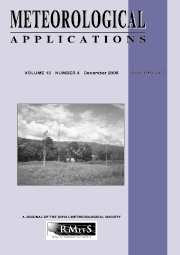Article contents
Dynamical influence of large valleys on the propagation of coastally trapped disturbances
Published online by Cambridge University Press: 23 November 2000
Abstract
The influence on the propagation of coastally trapped disturbances (CTD) oflarge gaps in the bounding coastal mountains is studied via application ofthe Colorado State University Regional Atmospheric Modeling System(RAMS). By large gap it is meant that the width is of order 25–50% ofthe Rossby radius. In order to isolate the effects of the gaps, idealisedsimulations are used. Thus, RAMS is configured with a straight north-southcoastline with a ramp-shaped coastal mountain range in which a gap isinserted and a gravity current-like CTD generated through cooling the lowlevel atmosphere at the southern end of the domain. Radiative, land surfaceand cloud parameterisations are turned off to avoid sea breeze generationand other thermal effects and to focus on the dynamical effect of thegaps. Four simulations are conducted: no gap in the coastal mountainbarrier, an insertion of a narrow (80 km) gap, a wide (160 km) gap, and anidealised island in the barrier. It is found that the gaps influence CTDpropagation by effectively stalling the propagation at their mouth for aperiod and subsequently weakening the gravity current-like features(vertical extent, strength and abruptness of the wind and stratificationchanges at the leading edge). The idealised island has a less obvious impactsince it is bounded by relatively narrow straits and does not allowcommunication with the model interior like the gaps do. Although lack ofdata and the nature of the idealised simulation prevents a detailedassessment of the simulations against real cases, qualitative comparisonswith observed events in western North America and south-eastern Australiaare made. Application of these results to air quality and forecasting issuesis discussed.
Information
- Type
- Research Article
- Information
- Copyright
- © 2000 Cambridge University Press
- 4
- Cited by

